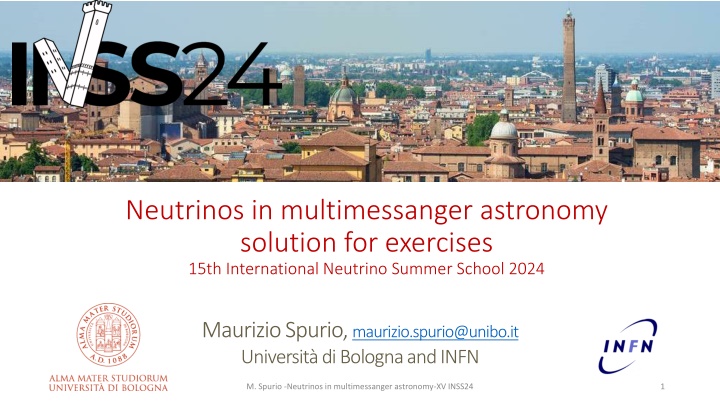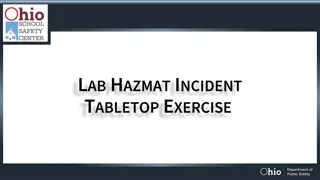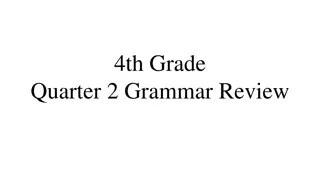
Neutrinos in Multimessenger Astronomy: Solutions for Exercises at International Neutrino Summer School 2024
Explore solutions and discussions on neutrinos in multimessenger astronomy through exercises from the 15th International Neutrino Summer School 2024. Topics covered include charged cosmic rays, direct and indirect cosmic ray detection, galactic accelerators, extragalactic sources, high-energy neutrino astrophysics, gravitational waves, and more.
Download Presentation

Please find below an Image/Link to download the presentation.
The content on the website is provided AS IS for your information and personal use only. It may not be sold, licensed, or shared on other websites without obtaining consent from the author. If you encounter any issues during the download, it is possible that the publisher has removed the file from their server.
You are allowed to download the files provided on this website for personal or commercial use, subject to the condition that they are used lawfully. All files are the property of their respective owners.
The content on the website is provided AS IS for your information and personal use only. It may not be sold, licensed, or shared on other websites without obtaining consent from the author.
E N D
Presentation Transcript
Neutrinos in multimessanger astronomy solution for exercises 15th International Neutrino Summer School 2024 Maurizio Spurio, maurizio.spurio@unibo.it Universit di Bologna and INFN M. Spurio -Neutrinos in multimessanger astronomy-XV INSS24 1
Didactic material Index of contents 1. An Overview of Multimessenger Astrophysics 2. Charged Cosmic Rays in Our Galaxy 3. Direct Cosmic Ray Detection 4. Indirect Cosmic Ray Detection 5. Diffusion of Cosmic Rays in the Galaxy 6. Galactic Accelerators and Acceleration Mechanisms 7. The Extragalactic Sources and UHECRs 8. The Sky Seen in -rays 9. The TeV Sky and Multiwavelength Astrophysics 10. High-Energy Neutrino Astrophysics 11. Atmospheric Muons and Neutrinos 12. Low-Energy Neutrino Physics and Astrophysics 13. Basics on the Observations of Gravitational Waves 14. Microcosm and Macrocosm https://www.dropbox.com/s/31mhpdxrgc2qse0/astroparticle-IIedc.pdf?dl=0 (my preprint version) M. Spurio -Neutrinos in multimessanger astronomy-XV INSS24 2
Answers to exercises and discussion arguments M. Spurio -Neutrinos in multimessanger astronomy-XV INSS24 3
Ex 1: The Sun age in EM burning Calorific value coal (lignite)= 24 MJ/kg, without ash production Calorific value of the Sun, imagined as a mass charcoal ball of 2x1030 kg Q= 4 1037 J = 4 1044 erg (means that the power for 1 hour of operation is equivalent to 24 MJ/3600 s= 6600 W) solar constant = 1.4 106 erg/cm2 s; Sun-Earth distance D= 1.5 1013 cm Power delivered by the sun dE/dt= ( D2) = 4 1033 erg/s Time to burn the Sun : T T1 1= Q/( = Q/(dE dE/ /dt dt) =4 10 ) =4 1044 erg /(4 1033 erg/s) = 1011 s= 3300 y 44 erg /(4 10 33 erg/s) = 10 11 s= 3300 y Ex 2: The Lord Kelvin Sun age extimation Total gravitational potential energy of a sphere of mass Msunof radius R is ? =3??2 1048 ??? 5? 1048 ??? 4 1033 ???/? 3 1014 ? = 107 ? ? ?2= dE/dt= M. Spurio -Neutrinos in multimessanger astronomy-XV INSS24 4
Ex 3: The Sun age in nuclear fusion Nuclear size is 10-6the dimension of atoms Colombian repulsion energy between protons must be 106higher than atomic binding energy Nuclear binding energy 106higher than atomic binding energy The Sun age must be 106higher than foreseen in exercise 1, i.e. order of few 109y M. Spurio -Neutrinos in multimessanger astronomy-XV INSS24 5
Exercize 4: The SN1987A: how many events? 1- Energy released 2.5 1053 erg 2- Average eenergy 16 MeV = 2.5 10-5 erg 3- Nsource= (1/6) 2.5 1053/ (2.5 10-5)= 1.7 1057 e 4- LMC Distance : D=52 kpc = 1.6 1023cm 5- Fluency at Earth: F = NSource/4pD2 = 0.5 1010 cm-2 6- Targets in 1 Kt water: Nt= 0.7 1032protons 7- cross section: ( e+p) ~ 2x10 2x10- -41 41 cm cm2 2 8- Ne+ = F (cm-2) (cm2) Nt(kt-1)= 0.5 1010 2x10-41 0.7 1032 = 7 positrons/kt 9 M(Kam II) = 2.1 kt, efficiency ~ 80% 10 Events in Kam II = 7 x 2.1 x e ~ 12 events 12 events For a SN @ Galactic Center (8.5 kpc) : N events= 7x(52/8.5)2= 260 e+/kt IMB had smaller PMTs that Kamiokende, less covered area, thus an higher energy threshold (20 MeV) and a much smaller detection efficiency Exercize 5: M. Spurio -Neutrinos in multimessanger astronomy-XV INSS24 6
Ex 6: Neutrino mass limit from SN The observation of SN s brings a better understanding of the core collapse mechanism from the feature of the time and energy spectra; Moreover, an estimation of the neutrino masses could be done in the following manner. The velocity of a particle of energy E and mass m, with E >> m, is given by (with c = 1): 2 ?2?4 ?? ~1 ?2?4 ??=??? = 2 2 ?? ?? 2?1 Thus, for a SN at distance d, the delay of a from the highest/lowest energy neutrino, E, due to its mass is (in proper units) ?[??2] ?[???]?[???] 2 ?[?]~0.05 Therefore, neutrinos of different energies released at the same instant should show a spread in their arrival time. For SN1987A, assuming Kam data and t=13 s, E=30 MeV and d=50 kpc, we get: ??2< 12 ?? M. Spurio -Neutrinos in multimessanger astronomy-XV INSS24 7
EX 8: Attenuation of 100 TeV gamma-rays The process is the interaction of the HE photon (E ) against the CMB (ECMB 1 meV) with (nCMB=400/cm3) and the creation of an e+e-pair 1. 2. The kinematics is identical to that of the GZK effect (see 7.5.2 of [1]). The energy of the photons must be almost equal to the energy necessary for the creation of 2me, i.e. (2??)2 2????(1 ????) 4???? 2 1 ???2 4?? 4 (1.2 10 3??) 1014 ?? ??= 3. The Feynman diagram: The e+e-cross section for the EM annihilation at low energies is ? 2??2 ? Thus, the mean free path = (?????) 1is: = (0.13 10 24 400) 1= 2 1022?? = 6000 ??. 4. ( ?)2=2?(1/137)2 0.4 ???2?? = 0.13 barn (2??)2 M. Spurio -Neutrinos in multimessanger astronomy-XV INSS24 8
Ex 9: Neutron decay ? ?=109 The Lorentz factor is ? = 1thus ? = ??? = 109 3 1010 1000 = 3 1022cm 1 pc = 3 x 1018cm, thus ? = 104 ?? O(10 kpc) is the typical radius of a spiral Galaxy M. Spurio -Neutrinos in multimessanger astronomy-XV INSS24 9
Ex 10: Neutrino cross section 0.4 ? The cross section ? = 1.5 10 34 1. (see red dashed line) 10 ??? The ?2= 2????term in the propagator cannot be negled w.r.t. the ?? The ??? scattering occurs through the t channel. But at the energy of the formation of a formation of a W- in the s channel, there is a resonant enhancement of the cross section. 2 2. 3. 4. This occurs at energy 2????= ?? 2or 2 ?? 2?? ??= = 6.3 PeV M. Spurio -Neutrinos in multimessanger astronomy-XV INSS24 10
Comparision with LAT effective area Fermi-LAT = pair-conversion telescope Fermi-LAT effective area vs. E for normal -ray incidence The Aeffis a fundamental quantity: The number of observed events is the integral over energy of the neutrino flux [cm2s GeV]-1with Aeff[cm2] LAT: Almost 90% of incoming -rays are detected (=converted into observable particles), if the g-ray is within the correct energy range. Below, the tracks are too short to be observed; at higher energies, the containment of the calorimeter is insufficient. M. Spurio -Neutrinos in multimessanger astronomy-XV INSS24 11
Ex 12: How many sensors in a 1km3NT N = L 300 /cm= 3x107 1) In the ANTARES/IC OMs Npe= (OMs VOM N QE )/1 km3 =100 OMs=5000 10 PMT =0.05 m2 This is the order of OMs buried in IceCube. ANTARES has 900 OMs 2. For KM3NeT the area of 31 PMTs of 3 is equivalent to that of 3PMTs of 10 . Thus, 1/3 of OMs are needed Lass~60 m VOM=3 m3 M. Spurio -Neutrinos in multimessanger astronomy-XV INSS24 12
M. Spurio -Neutrinos in multimessanger astronomy-XV INSS24 13






















